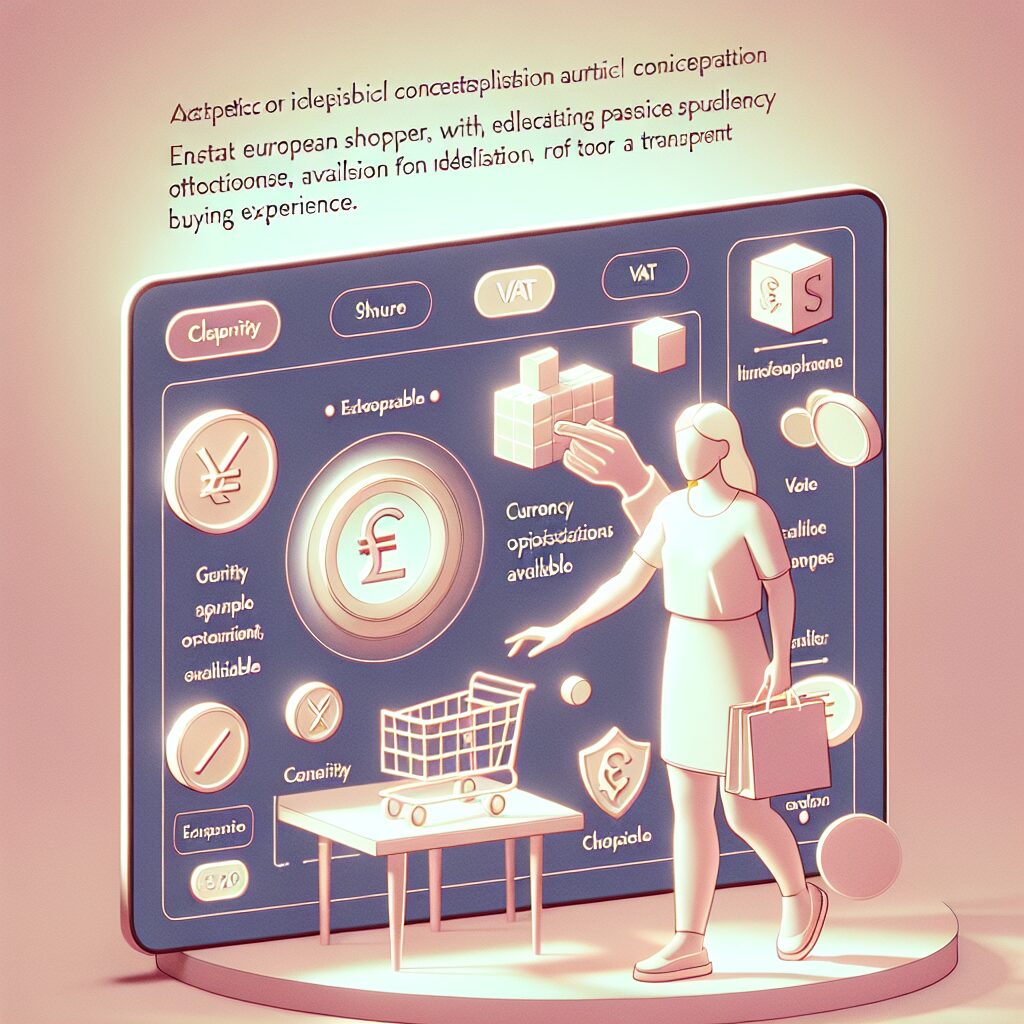About eldris
Clone.Eldris.ai empowers brands to instantly replicate and translate their websites for seamless global expansion. Our automated system delivers SEO-friendly, multilingual clones that launch in days, not months.
In This Article
- Display VAT clearly and in line with local laws for each EU country.
- Use automated tools to handle VAT calculation and currency detection efficiently.
- Localise checkout language, currency, and formatting to regional norms.
- Implement regional payment methods to improve conversion rates.
- Test and update your checkout process regularly to maintain compliance.
Overview of the EU E-commerce Checkout Landscape
Why Localization Matters in Checkout
Entering the European e-commerce market demands more than simply translating your website. True success relies on mastering core EU checkout best practices, where localisation plays a pivotal role in driving conversion and customer trust. The European Union comprises 27 distinct countries, each with its own languages, cultural preferences, legal obligations, and consumer behaviour patterns. Hence, a one-size-fits-all checkout experience is not only ineffective—it can result in lost sales and compliance risks.
Shoppers across Europe expect a frictionless checkout process tailored to their geographical and cultural context. They want to view prices in their local currencies, interact with sites in their native languages, and trust that VAT charges are accurate and transparent. A localised checkout not only increases conversion rates but also builds long-term brand affinity. According to the latest research, 76% of European shoppers say they’re more likely to buy from a retailer that offers a localised experience.
Additionally, EU consumer protection laws are stringent, especially regarding data protection, VAT disclosure, and language accessibility. Meeting these expectations through correct localisation is more than a growth tactic—it’s a compliance imperative. One way businesses have responded is by adopting intelligent localisation frameworks and leveraging automated tools tailored for EU markets. Platforms like Eldris, for example, allow cloned and localised experiences that respect all regional nuances without overwhelming development teams. Begin this localisation journey by ensuring the basics are right: local language, currency, tax calculations, and legal compliance.

Understanding VAT Requirements in EU Countries
Legal and UX Aspects of VAT Display
VAT (Value-Added Tax) is a consumption tax levied on the sale of goods and services throughout the European Union. As part of adhering to EU checkout best practices, VAT display and calculation must be both legally compliant and user-friendly. Every EU country mandates that VAT must be either included in the displayed price or clearly stated during the checkout process. Failure to do so can result in legal penalties and customer dissatisfaction.
To comply, businesses must understand the distinction between Business-to-Consumer (B2C) and Business-to-Business (B2B) transactions. For B2C, VAT should almost always be included in the displayed price—shoppers should not be surprised at checkout. For B2B, reverse-charge mechanisms may apply, and valid VAT identification numbers are often required. It’s critical to maintain validation systems for VAT numbers and display tax breakdowns accurately, especially as shoppers transition through different stages of the funnel.
From a user experience perspective, transparency is key. You must clearly communicate whether VAT is included in the product price and provide a full breakdown during the final stage of checkout. It is advisable to include tooltips or hover explanations for tax components, enhancing clarity without overwhelming the shopper. Furthermore, ensure that systems are robust enough to dynamically adjust for different VAT rates across EU countries as required.
“Transparency in VAT handling isn’t just a legal requirement—it’s fundamental to fostering trust in EU shoppers.”
Best Practices for Displaying Local Currency
Displaying prices in local currency is one of the most direct ways to improve conversion in the European market. Consumers feel far more secure when pricing is familiar and predictable. As part of your EU checkout best practices roadmap, it’s essential that your platform auto-detects a user’s location and presents pricing accordingly.
For example, if a shopper from France visits your Dutch site, pricing should automatically reflect Euros and align with French VAT expectations. This not only streamlines the purchase process but also removes cognitive friction. Additionally, display conversion tools or toggles that allow users to manually switch currencies can further personalise the experience.
You should also provide side-by-side conversions if your pricing deviates significantly from local expectations due to market or logistic factors. Be consistent in currency formatting—do not mix periods and commas incorrectly—and always place the currency symbol correctly. Most importantly, regularly update your exchange rates to reflect accurate costs.
Tools to Automate VAT Calculation and Currency Detection
Automation is the cornerstone of efficient, scalable compliance. Fortunately, several tools and plugins exist specifically to handle complex VAT rules and currency conversions within European markets. Shopify Plus, Magento, and WooCommerce have extensions that localise pricing and even calculate VAT dynamically based on postal code.
Advanced solutions like Avalara and TaxJar integrate seamlessly with popular e-commerce frameworks, applying the correct VAT rate and updating localised tax schema in real-time. Most also support VAT number validation, crucial for B2B checkouts. Use these solutions to generate legally compliant invoices and make federal submissions simpler.
Currency detection tools, such as GeoIP-based APIs, work alongside VAT engines to ensure seamless localisation. Combined, they allow platforms like Eldris to create hyper-local commerce experiences that comply out of the box. Integrating these tools from the onset allows for smoother operations and reduces the burden on internal teams.
UX Optimisation Tips for Multilingual & Multiple Currency Checkout
Europe is a multilingual continent. Offering checkout experiences in a shopper’s native language is no longer optional—it’s expected. As part of EU checkout best practices, providing language options clearly at the top of your site creates instant user alignment. But don’t stop at translations; consider cultural nuances, phrasing, and even payment preferences for each region.
Your platform should also support right-to-left languages, depending on your customer base. High-performing sites often internationalise their UX copy elements, such as call-to-actions, error messages, and confirmation notices. Additionally, give equal care to multilingual SEO, page titles, and meta descriptions to support discoverability.
On the currency side, keep formatting consistent. For instance, German users expect commas for decimal points, while Finnish consumers expect currency symbols after the amount. Applying native conventions prevents user confusion and fosters trust. Remember that misinterpreted prices can drive cart abandonment.
Case Studies: Success with Localised EU Checkouts
Consider the UK-based fashion retailer that expanded into Scandinavia using Eldris. They localised their checkout using native languages (Swedish, Finnish, and Danish), added country-specific VAT calculations, and harmonised pricing in SEK, EUR, and DKK respectively. The result? A 28% uplift in their conversion rate and a 17% decrease in cart abandonment.
Another example is a Dutch electronics brand that implemented a fully localised checkout for Germany using Learn more about E-commerce Localisation for European Markets. By showcasing prices inclusive of VAT and offering familiar payment options like Klarna and SOFORT, they doubled their returning customer base within four months.
Strategies like these exemplify EU checkout best practices in action—built on localisation, automation, and customer understanding. Data consistency, language clarity, and legal adherence are crucial success factors for any e-commerce brand entering the European economic area.
Common Pitfalls & How to Avoid Them
It’s easy to make critical mistakes when scaling into EU markets. One common issue involves incorrectly applying VAT across borders, especially with cross-border shipping. A failure to clearly label whether pricing includes VAT can also discourage purchase completion. Moreover, redirecting users based on IP without giving them control frustrates users and may violate GDPR.
Neglecting local payment methods is another frequent misstep. Many regions prefer regional solutions: Italians often favour PostePay; Germans lean toward bank transfers. Excluding these could undermine other localisation efforts. Also, inaccurate currency exchange rates can mislead consumers, causing unexpected price disparities.
Avoid these pitfalls by using geolocation carefully, offering granular payment customisation, and adhering religiously to EU checkout best practices. Perform routine audits and user testing, just as you would for your domestic checkout process.
Maintaining Compliance as EU Regulations Evolve
European regulations are continually evolving. New directives like the Digital Services Act, PSD2’s enhanced security requirements, and ongoing GDPR updates mean e-commerce brands must stay agile. Compliance is not a one-time event—it requires monitoring, adaptation, and internal coordination.
Use compliance dashboards or third-party compliance risk platforms to track changes in taxation, data mandates, and consumer rights regulation across EU nations. Your legal and development teams must collaborate closely, particularly as cross-border trade grows more complex.
Build compliance into your product roadmap and ensure that every deployment is reviewed for conformity to both legal and user-experience standards. By doing so, you’ll uphold user trust and reduce the threat of litigation or fines—a vital tenet of EU checkout best practices.
Using Eldris to Clone and Localize with Speed and Precision
Eldris provides a fast and intelligent mechanism for deploying EU checkout best practices at scale. Brands use Eldris to clone nationalised versions of their online stores, each with accurate VAT, language, and currency. Unlike monolithic content systems or site builders, Eldris enables component-level localisation without coding bloat.
It integrates smoothly with existing stacks and allows marketers and developers to collaborate asynchronously. Whether you need German VAT accuracy, French baguette metaphors in your copy, or flawless compliance with Swedish payment laws, Eldris can model and deploy these changes in minutes—not months.
Best of all, Eldris validates every module against market rules. From RTL support in Cyprus to invoice compliance in Hungary, Eldris ensures every transformation is accurate down to the detail. Explore Read a related article to dive deeper into platform capabilities.
Integrations with Payment Providers and Tax Services
A robust checkout stack involves seamless integration with regional payment gateways and VAT services. Stripe, Adyen, and Worldline offer extensive EU coverage, enabling local payment options while meeting security mandates like Strong Customer Authentication (SCA). These providers support methods such as Bancontact (Belgium), iDEAL (Netherlands), and Sofort (Germany).
Integrating with reliable tax compliance platforms ensures that tax rates are always up to date. Use optional APIs to validate VAT IDs, determine place-of-supply rules based on product type, and localise price summaries. Gateway integrations should be tested during checkout QA processes to confirm they work flawlessly across countries.
Also consider tools like Best practices for e-commerce checkout localisation, which offer both payment and tax record integration, reducing operational complexity and ensuring smoother payment finalisation for the end user.
Conclusion: Building Trust with Transparent Checkout
Mastering EU checkout best practices demands more than ticking regulatory boxes. It’s about delivering a culturally aligned, legally compliant, and frictionless experience that European shoppers expect. By focusing on transparency, automation, and personalisation, brands build trust and boost their bottom line simultaneously.
Each aspect—VAT clarity, local currency and language, legal adherence, and UX polish—must work in harmony to elevate the user journey. Investing in tools like Eldris empowers teams to execute this flawlessly. The takeaway? Prioritise EU localisation today to futureproof your brand expansion across Europe’s high-value markets.
Great guide on eu-checkout-vat-localisation-best-practices – Community Feedback
How should VAT be displayed for EU customers during checkout?
VAT must be shown clearly alongside product prices and in the final checkout summary. Retailers should display the local VAT rate based on the customer’s shipping address and provide total price transparency to ensure compliance and build trust.
What are the benefits of offering local currencies at checkout?
Displaying local currencies reduces purchase friction, increases customer trust, and can significantly lift conversion rates as buyers see familiar prices. It also prevents confusion and chargebacks due to unclear pricing.
How can I ensure my checkout is compliant across all EU member states?
Use automated systems to detect customer location, apply correct VAT rates, and display prices in local currencies. Stay updated on EU regulations and regularly audit processes to prevent compliance issues.










